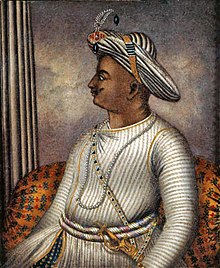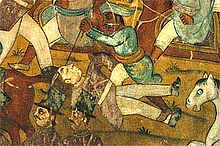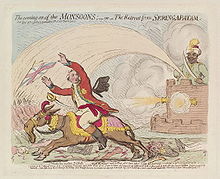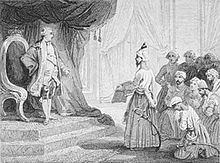| Tipu Sultan | |
|---|---|
| Ruler of Mysore | |
 | |
| Reign | 1782–1799 |
| Born | 20 November 1750 |
| Birthplace | Devanahalli |
| Died | 4 May 1799 (aged 48) |
| Place of death | Seringapatam |
| Buried | Seringapatam |
| Predecessor | Hyder Ali |
| Successor | Krishnaraja Wodeyar II |
| Royal House | |
| Father | Hyder Ali |
| Mother | Fakhr-un-nissa |
| Religious beliefs | Islam |
Tipu Sultan (Kannada: ಟಿಪ್ಪು ಸುಲ್ತಾನ್, Urdu: سلطان فتح علی خان ٹیپو) (November 1750, Devanahalli – 4 May 1799, Seringapatam), also known as the Tiger of Mysore, was the de facto ruler of the Kingdom of Mysore. He was the son of Hyder Ali, at that time an officer in the Mysorean army, and his second wife, Fatima or Fakhr-un-nissa. He was given a number of honorific titles, and was referred to as Sultan Fateh Ali Khan Shahab, Tipu Saheb, Bahadur Khan Tipu Sultan or Fatih Ali Khan Tipu Sultan Bahadur.
During Tipu's childhood, his father rose to take power in Mysore, and Tipu took over rule of the kingdom upon his father's death. In addition to his role as ruler, he was a scholar, soldier, and poet. He was a devout Muslim but the majority of his subjects were Hindus. At the request of the French, he built a church, the first in Mysore. He was proficient in many languages.[1] In alliance with the French in their struggle with the British, and in Mysore's struggles with other surrounding powers, both Tipu Sultan and Hyder Ali used their French trained army against the Marathas, Sira, Malabar, Coorg, Bednur, Carnatic, and Travancore. He won important victories against the British in the Second Anglo-Mysore War, and negotiated the 1784 Treaty of Mangalore with them after his father died the previous year.
He engaged in expansionist attacks against his neighbors, and harshly put down rebellions within his territories, deporting whole populations into confinement in Seringapatam. He remained an implacable enemy of the British, bringing them into renewed conflict with an attack on British-allied Travancore in 1789. In the Third Anglo-Mysore War Tipu was forced into a humiliating peace, losing a number of previously conquered territories, such as Malabar and Mangalore. He sent embassies to foreign states, including the Ottoman Empire and France, in an attempt to rally opposition to the British. In the Fourth Anglo-Mysore War the combined forces of the British East India Company and the Nizam of Hyderabad defeated Tipu and he was killed on 4 May 1799, defending the fort of Seringapatam.
Tipu's treatment of conquered subjects, non-Muslims, and prisoners of war, were controversial, and continue to be a subject of debate today. He introduced a number of administrative and military innovations to Mysore (including the expansion of rocket technology), and introduced and promoted a more widespread use of Persian and Urdu languages in southern India.
| “ | Although I never supposed that he (Napoleon) possessed, allowing for some difference of education, the liberality of conduct and political views which were sometimes exhibited by old Hyder Ali, yet I did think he might have shown the same resolved and dogged spirit of resolution which induced Tipu Sahib to die manfully upon the breach of his capital city with his sabre clenched in his hand. | ” |
| —Sir Walter Scott, commenting on the abdication of Napoleon Bonaparte in 1814 | ||
Contents |
Early years
Childhood
Tipu Sultan was born at Devanahalli, in present-day Bangalore District, some 33 km (21 mi) North of Bangalore city. The exact date of his birth is not known; various sources claim different dates between 1749 and 1753. According to one widely accepted dating, he was born on 20 November 1750 (Friday, 10th Dhu al-Hijjah, 1163 AH). His father, Hyder Ali, was a military officer in service to the Kingdom of Mysore; he rapidly rose in power, and became the de facto ruler of Mysore in 1761. His mother Fatima or Fakhr-un-nissa was the daughter of the governor of the fort of Kadapa.
Early military service

Tipu Sultan was instructed in military tactics by French officers in the employment of his father, Hyder Ali (also spelled "Haidar Ali"). At age 15, he accompanied his father against the British in the First Mysore War in 1766. He commanded a corps of cavalry in the invasion of Carnatic in 1767 at age 16. He also distinguished himself in the First Anglo-Maratha War of 1775–1779.[citation needed]
Alexander Beatson, who published a volume on the Fourth Mysore War entitled View of the Origin and Conduct of the War with Tippoo Sultaun, described Tipu Sultan as follows: "His stature was about five feet eight inches; he had a short neck, square shoulders, and was rather corpulent: his limbs were small, particularly his feet and hands; he had large full eyes, small arched eyebrows, and an aquiline nose; his complexion was fair, and the general expression of his countenance, not void of dignity".[3]
Second Mysore War
In 1779, the British captured the French-controlled port of Mahé, which Tipu had placed under his protection,providing some troops for its defence. In response, Hyder launched an invasion of the Carnatic, with the aim of driving the British out of Madras.[4] During this campaign in September 1780, Tipu Sultan was dispatched by Hyder Ali with 10,000 men and 18 guns to intercept Colonel Baillie who was on his way to join Sir Hector Munro. In the Battle of Pollilur, Tipu decisively defeated Baillie. Out of 360 Europeans, about 200 were captured alive, and the sepoys, who were about 3800 men, suffered very high casualties. Munro was moving south with a separate force to join Baillie, but on hearing the news of the defeat he was forced to retreat to Madras, abandoning his artillery in a water tank at Kanchipuram.[5]

Tipu Sultan defeated Colonel Braithwaite at Annagudi near Tanjore on 18 February 1782. Braithwaite's forces, consisting of 100 Europeans, 300 cavalry, 1400 sepoys and 10 field pieces, was the standard size of the colonial armies. Tipu Sultan seized all the guns and took the entire detachment prisoner. In December 1781 Tipu Sultan successfully seized Chittur from the British. Tipu Sultan had thus gained sufficient military experience by the time Hyder Ali died on Friday, 6 December 1782 - some historians put it at 2 or 3 days later or before, (Hijri date being 1 Muharram, 1197 as per some records in Persian - there may be a difference of 1 to 3 days due to the Lunar Calendar). Tipu Sultan realized that the British were a new kind of threat in India. He became the ruler of Mysore on Sunday, 22 December 1782 ( The inscriptions in some of Tipu Regalia showing it as 20 Muharram, 1197 Hijri - Sunday ), in a simple coronation ceremony. He then worked to check the advances of the British by making alliances with the Marathas and the Mughals.
The Second Mysore War came to an end with the 1784 Treaty of Mangalore. It was the last occasion when an Indian king dictated terms to the British, and the treaty is a prestigious document in the history of India.[6] The war is also remembered for alleged excesses committed by Hyder Ali and Tipu Sultan in Tanjore.[7] During the period of occupation which lasted six months, Hyder Ali and Tipu Sultan are believed to have impoverished the country, destroying crops and cattle.[7] As late as 1785, the Dutch missionary Christian Friedrich Schwarz describes Tipu's alleged abduction of 12,000 children from the region.[7] The economic output of Tanjore is estimated to have fallen by 90% between 1780 and 1782.[8] The ravages of Hyder and Tipu were followed by alleged expeditions of plunder launched by the Kallars. The economic devastation wrought by these attacks was so severe that Tanjore's economy did not recover until the start of the 19th century; the era is referred to in local folklore as the Hyderakalam.[7]
Rule of Mysore
While leading a predominantly Hindu country, Tipu remained strong in his Muslim faith, going daily to say his prayers and paying special attention to mosques in the area.[9] He built a church, the first in Mysore, on French request.
During his rule, Tipu Sultan laid the foundation for a dam where the famous Krishna Raja Sagara Dam across the river Cauvery was later built.[10][11] He also completed the project of Lal Bagh started by his father Hyder Ali, and built roads, public buildings, and ports along the Kerala shoreline. His dominion extended throughout North Bangalore including the Nandi Hills, Kanivenarayanapura, and Chickballapur. His trade extended to countries which included Sri Lanka,Oman,Afghanistan, France, Turkey, and Iran. Under his leadership, the Mysore army proved to be a school of military science to Indian princes. The serious blows that Tipu Sultan inflicted on the British in the First and Second Mysore Wars affected their reputation as an invincible power. Dr. APJ Abdul Kalam, the former President of India, in his Tipu Sultan Shaheed Memorial Lecture in Bangalore (30 November 1991), called Tipu Sultan the innovator of the world's first war rocket. Two of these rockets, captured by the British at Seringapatam, are displayed in the Royal Artillery Museum in London. He managed to subdue all the petty kingdoms in the south. He defeated the Marathas and the Nizams and was also one of the few Indian rulers to have defeated British armies. He is said to have started new coinage, calendar, and a new system of weights and measures mainly based on the methods introduced by French technicians. He was well versed in Urdu, Kannada, Persian, and Arabic. Tipu was supposed to become a Sufi, but his father Hyder Ali insisted he become a capable soldier and a great leader. Tipu is also infamous for the inhuman atrocities committed during his invasion of South Kanara, Kodagu and Malabar. The revolt against Tipu's rule in Malabar was crushed. The Sirian Christians and Hindus were persecuted in these regions with plunder, destruction places of worship, and mass conversions. The main deity at the famous Guruvayur Temple had to be shifted to Ambalapuzha due to the imminent attack from Tipu's forces. The King of Kozhikode (Samudiri/Zamorin) committed suicide in his palace to avoid capture by Tipu. Members of the royal family of Chirakkal were deported to Mysore. There were large scale migration of people to the kingdom of Travancore, fearing persecution. In fact, historically the region south of the Tungabhadra river was relatively immune to the great ravages and plunder from attacking armies unlike those in the Northern parts of India. The only two exception to the aforementioned were the acts of Hyder Ali/ Tipu Sultan in Malabar- Kodagu- South Kanara regions and the sacking and destruction of Vijayanagara.
Third Mysore War


In 1789, Tipu Sultan disputed the acquisition by Dharma Raja of Travancore of two Dutch-held fortresses in Cochin, which was a Mysorean tributary. In December 1789 he massed troops at Coimbatore, and on 28 December made an attack on the lines of Travancore, knowing that Travancore was (according to the Treaty of Mangalore) an ally of the British East India Company. On account of the staunch resistance by the Travancore army, Tipu was unable to break through the Tranvancore lines and the Maharajah of Travancore appealed to the East India Company for help. In response, Lord Cornwallis mobilized company and British military forces, and formed alliances with the Marathas and the Nizam of Hyderabad to oppose Tipu. In 1790 the company forces advanced, taking control of much of the Coimbatore district. Tipu counterattacked, regaining much of the territory, although the British continued to hold Coimbatore itself. He then descended into the Carnatic, eventually reaching Pondicherry, where he attempted without success to draw the French into the conflict.
In 1791 his opponents advanced on all fronts, with the main British force under Cornwallis taking Bangalore and threatening Seringapatam. Tipu harassed his enemy's supply and communication and embarked on a "scorched earth" policy of denying local resources to the invaders. In this last effort he was successful, as the lack of provisions forced Cornwallis to withdraw to Bangalore rather than attempt a siege of Seringapatam. Following the withdrawal, Tipu sent forces to Coimbatore, which they retook after a lengthy siege.
The 1792 campaign was a failure for Tipu. The allied army was well-supplied, and Tipu was unable to prevent the junction of forces from Bangalore and Bombay before Seringapatam. After about two weeks of siege, Tipu opened negotiations for terms of surrender. In the ensuing treaty, he was forced to cede one half of Mysore's territory to the allies, and deliver two of his sons as hostages of war.
Napoleon's attempt at a junction

One of the motivations of Napoleon's Invasion of Egypt was to establish a junction with India against the British. Bonaparte wished to establish a French presence in the Middle East, with the ultimate dream of linking with Tippoo Sahib.[13] Napoleon assured to the French Directory that "as soon as he had conquered Egypt, he will establish relations with the Indian princes and, together with them, attack the English in their possessions."[14] According to a 13 February 1798 report by Talleyrand: "Having occupied and fortified Egypt, we shall send a force of 15,000 men from Suez to India, to join the forces of Tipu-Sahib and drive away the English."[14] Napoleon was unsuccessful in this strategy, losing the Siege of Acre in 1799, and at the Battle of Abukir in 1801.[15]
Fourth Mysore War

After Horatio Nelson had defeated François-Paul Brueys D'Aigalliers at the Battle of the Nile in Egypt in 1798, three armies, one from Bombay, and two British (one of which included Arthur Wellesley, the future first Duke of Wellington), marched into Mysore in 1799 and besieged the capital Seringapatam in the Fourth Mysore War.
There were over 26,000 soldiers of the British East India Company comprising about 4000 Europeans and the rest Indians. A column was supplied by the Nizam of Hyderabad consisting of ten battalions and over 16,000 cavalry, and many soldiers were sent by the Marathas. Thus the soldiers in the British force numbered over 50,000 soldiers whereas Tipu Sultan had only about 30,000 soldiers. The British broke through the city walls, and Tipu Sultan died defending his capital on May 4. When the fallen Tipu was identified, Wellesley felt his pulse and confirmed that he was dead. Next to him, underneath his palankeen, was one of his most confidential servants, Rajah Cawn. Rajah was able to identify Tipu for the soldiers. Tipu Sultan was killed at the Hoally (Diddy) Gateway, which was located 300 yards (270 m) from the N.E. Angle of the Seringapatam Fort. The Fort Gateway had been built only 5 years prior to Tipu's death.[16] Tipu was buried the next afternoon, near the remains of his father. In the midst of his burial, a great storm struck, with massive winds and rains. As Lieutenant Richard Bayly of the British 12th regiment wrote, "I have experienced hurricanes, typhoons, and gales of wind at sea, but never in the whole course of my existence had I seen anything comparable to this desolating visitation".[17]
Immediately after the death of Tipu Sultan many members of the British East India Company believed that Umdat Ul-Umra the Nawab of Carnatic secretly provided assistance to Tipu Sultan during the Fourth Anglo-Mysore War and immediately sought his deposition after the year 1799.
Leadership, policy, and innovations
Tipu introduced a new calendar, new coinage, and seven new government departments, during his reign, and made military innovations in the use of rocketry.




No comments:
Post a Comment